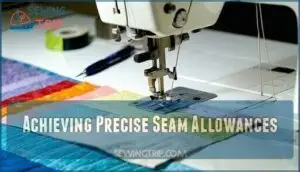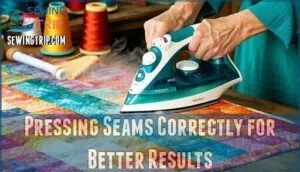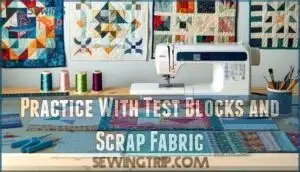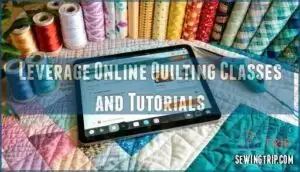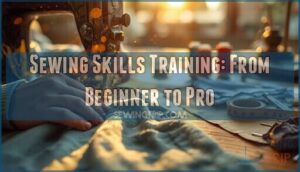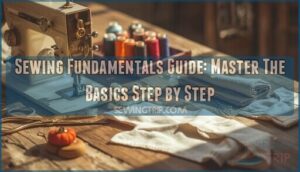This site is supported by our readers. We may earn a commission, at no cost to you, if you purchase through links.

Online tutorials let you pause, rewind, and replay tricky techniques until they click. You can watch an expert’s hands position fabric for accurate cuts, then immediately try it yourself at your own machine. With the right strategies, you’ll hone your technique faster than any in-person class could manage, building skills one careful seam at a time.
Table Of Contents
Key Takeaways
- Accurate cutting with sharp rotary blades and quality rulers, combined with consistent quarter-inch seam allowances, forms the foundation that prevents small errors from compounding throughout your entire quilt design.
- Practicing with test blocks and scrap fabric before cutting into expensive yardage transforms mistakes into low-pressure learning opportunities while building muscle memory through repetition.
- Online quilting classes and video tutorials let you pause, rewind, and replay tricky techniques at your own pace, with 70% of quilters reporting faster skill improvement compared to traditional classes alone.
- Joining online quilting communities and participating in quilt-along projects provides real-time feedback from experienced quilters, structured deadlines for completion, and the motivation that comes from shared progress and support.
Master Accurate Cutting and Piecing Techniques
Think of cutting and piecing as the foundation of every quilt you make. If your cuts are off by even a quarter inch, those small errors add up quickly and throw off your entire design.
Here’s what you need to focus on to get clean, accurate results every time.
Using Sharp Rotary Cutters and Quality Rulers
When your rotary cutter glides through fabric like butter instead of dragging or skipping, you’ll know you’re working with a sharp blade—and that clean cut makes all the difference in how your quilt comes together.
Replace blades regularly for cutter maintenance, and invest in a variety of quilting rulers for cutting angles and curves. Quality rulers with clear markings help stabilize fabric and make cutting fabric safer, while ergonomic cutting mats reduce hand fatigue during longer sessions with your quilting tools.
Achieving Precise Seam Allowances
Your quilt blocks won’t fit together properly if your seam allowances vary even by an eighth of an inch, so learning to sew a consistent quarter-inch seam is one of the most important skills you can develop.
Use a quarter-inch foot on your machine for consistent fabric feeding, or mark a guide on your throat plate with painter’s tape.
Test your sewing accuracy on scraps first, and adjust your needle position until you nail that perfect seam allowance consistency every time.
Pressing Seams Correctly for Better Results
Once your seam allowances are spot-on, how you press those seams will make or break the flatness and accuracy of your finished blocks. Use a hot, dry iron and press—don’t drag—to avoid distortion.
Set your seam first, then open and press toward the darker fabric when possible. Consistent pressing in the right seam direction helps blocks nest together perfectly, improving quilting skills one seam at a time.
Practice With Test Blocks and Scrap Fabric
Before you cut into that beautiful fabric you’ve been saving, try your hand at a few practice runs first. Test blocks and scrap fabric give you a low-pressure way to work through new techniques and iron out any kinks.
Here’s how practicing smart can sharpen your skills without wasting a single yard of your good material.
Creating Sample Blocks Before Cutting Final Fabric
Before you commit your best fabric to a new pattern, making a sample block is like taking a practice swing—it lets you test your technique without the pressure of aiming for flawlessness. You’ll avoid fabric waste and gain confidence with each stitch.
Sample blocks help you fine-tune:
- Color testing combinations before cutting into expensive yardage
- Technique refinement for complex piecing blocks
- Scale adjustments to make sure pattern proportions work
- Design visualization of how your finished quilt will actually look
This approach transforms mistakes into learning opportunities while improving quilting skills.
Building Muscle Memory Through Repetition
Repeating the same cuts and seams over and over might feel tedious at first, but that’s exactly how your hands learn to work without your brain micromanaging every move. Consistent practice schedules turn unfamiliar quilting techniques into automatic responses.
Try skill reinforcement drills with scrap fabric, then gradually increase complexity as your confidence grows. This mindful quilting habit transforms the learning process into muscle memory, and online tutorials can guide your repetitive motion benefits perfectly.
Learning From Mistakes With a Seam Ripper
Every quilter keeps a seam ripper nearby because mistakes aren’t failures—they’re just part of the process. Think of stitch ripping as a reset button that gives you a second shot at getting things right.
Correcting common errors teaches you what went wrong and how to prevent it next time. Embrace imperfection—it’s how you discover real learning opportunities.
Plus, salvaging fabric means you’re not wasting materials while building skills that actually stick.
Leverage Online Quilting Classes and Tutorials
Online learning has transformed how quilters build their skills, offering flexibility you can’t find in traditional classes. Whether you’re drawn to live instruction or prefer learning at your own pace, the right course can help you tackle techniques that once seemed intimidating.
Here’s how to make the most of what’s available in 2025.
Choosing Between Live and Self-paced Courses
Your learning style matters when picking between live and self-paced online quilting classes. Live sessions offer real-time feedback and community—75% of quilters value that instructor interaction for building quilting skills. Self-paced courses let you revisit video tutorials anytime, which helps 65% master tricky techniques.
Consider your time commitment and cost comparison too. Live classes run $50-$150 per session with scheduled meetings, while self-paced options offer lifetime access for $30-$200. The convenience of online classes allows students to learn at their own pace.
Social interaction drives completion rates up 50% in live formats, but self-paced works better for unpredictable schedules.
Learning Free-motion and Ruler Quilting Remotely
Free-motion and ruler quilting look intimidating on screen, but remote learning breaks these techniques into manageable steps that click faster than you’d expect.
Online quilting classes offer virtual ruler guidance and digital pattern adaptation that mirror in-person instruction.
You’ll gain online critique benefits through video uploads, plus ergonomic setup remote tips that prevent fatigue.
Remote technique mastery happens when you pause, rewind, and practice free motion quilting designs until they become second nature.
Following Video Tutorials for Specific Techniques
Video tutorials act like a quilting mentor you can summon at midnight—ready to show you that tricky binding corner or appliqué stitch exactly when you need it.
You’ll find expert demonstrations that offer technique visualization and step-by-step guidance for quilting techniques you’ve avoided.
Pause for skill reinforcement, rewind for pattern adaptation, and replay until the moves feel natural—these quilting video tutorials transform frustrating moments into breakthroughs.
Join Online Quilting Communities and Guilds
Quilting doesn’t have to be a solo journey. Online communities and guilds connect you with fellow quilters who share tips, celebrate wins, and help you troubleshoot when things go sideways.
Here’s how to tap into that support and grow your skills faster.
Finding Support in Quilting Forums and Social Media
You don’t have to improve quilting skills alone. Online forums and social media groups connect you with thousands of quilters willing to share advice, answer questions, and cheer you on. Facebook groups, Instagram communities, and dedicated forums like The Quilt Show—with over 128,000 members—offer resource sharing, critique acceptance, and emotional support.
One popular section is the Quilting Community forums, where members discuss quilt shows and share vacation tips. Learning forum etiquette helps you ask better questions and contribute meaningfully.
Whether you’re finding quilting resources, seeking feedback on a tricky block, or simply enjoying the camaraderie of a quilting community, these spaces make joining a quilt guild feel accessible from anywhere.
Participating in Quilt-along Projects
Once you’re comfortable in online quilting spaces, jumping into a quilt-along project gives you structure, deadlines, and the motivation to finish what you start. These quilting along projects walk you through a quilting tutorial step-by-step, perfect for beginner quilting and skill development.
Quilt-alongs offer:
- Project selection curated by experienced hosts
- Fabric choices discussed within the quilting community
- Timeline management with weekly or monthly deadlines
- Community interaction through shared progress photos
- Skill development as quilting projects increase in complexity
Gaining Feedback From Experienced Quilters
As you share your work and watch others do the same, you’ll start to notice patterns in what makes a quilt shine—and that’s where asking for feedback from seasoned quilters can fast-track your progress.
Expert critiques through guild mentorship and online forums give you constructive criticism geared to your quilting project.
Whether you’re a beginner quilting your first block or improving quilting skills with a complex quilting tutorial, experienced quilters spot what you might miss and guide your skill improvement forward.
Use Modern Tools and Technology Effectively
You can’t ignore the tools that have changed the game in quilting. Modern machines and software open up possibilities that once took years to master, and knowing how to use them well can accelerate your progress substantially.
Here’s what you need to know about bringing technology into your quilting practice.
Exploring Computerized Machines and Design Software
With computerized quilting machines and digital quilting design software, you can explore endless quilting patterns and experiment with intricate quilting designs before cutting fabric. The software learning curve varies, but many quilting tutorial resources help you navigate machine automation benefits like precise stitching and repeatable quilt design layouts.
Computerized quilting costs range widely, though future quilting tech keeps advancing to make these tools more accessible for home quilters.
Adjusting Stitch Length and Machine Settings
After you’ve explored those sophisticated computerized features, fine-tuning your machine’s basic settings—like stitch length and tension—can make the difference between quilting blocks that lie flat and ones that pucker or gap. Dial in these fundamentals:
- Ideal Stitch Length: 2.0–2.5mm works for most piecing
- Tension Adjustment Tips: Test on scraps first
- Needle Type Matters: Match sharp or ballpoint to fabric
- Thread Weight Impact: Heavier thread needs looser tension
- Feed Dog Settings: Lower for free-motion work
Troubleshooting sewing machine issues becomes easier once you understand how each adjustment affects your stitches.
Choosing The Right Presser Feet for Projects
Swapping out your presser foot might seem like a small detail, but the right one can prevent fabric drag, tame bulky seams, and give you the control you need for tricky piecing or delicate topstitching. Match your presser foot to your project needs, and you’ll notice improved stitch quality immediately.
Check your sewing machine’s foot compatibility before investing in specialty feet. A walking foot feeds layers evenly, while a quarter-inch foot ensures consistent seam allowances.
Frequently Asked Questions (FAQs)
How do I choose the right online quilting instructor?
Think of an instructor who posts stunning quilts but never answers student questions—that’s a red flag.
Look for a clear teaching style in free previews, read course reviews from quilters at your skill level, and check if the instructor actively engages with their community through feedback and support.
What fabric types work best for beginner quilters?
Cotton fabric is your best friend when you’re starting out. It’s forgiving, holds its shape, and doesn’t fray as easily as other materials.
Precut fabrics from your local fabric store take the guesswork out of fabric selection and help you focus on technique instead.
How long does it typically take to finish a quilt?
The timeline hinges on project complexity and quilt size. A simple baby quilt might wrap up in a weekend, while king-sized masterpieces can stretch across months.
Your skill level and available time shape the pace—beginners need patience as they build quilting skills through each step.
Can I learn quilting without owning a sewing machine?
Yes, you can learn quilting without a machine through Hand Quilting and English Paper Piecing techniques.
These beginner quilting advice methods use Glue Basting and Fabric Manipulation, perfect for exploring quilting as a learning process using quilting tutorial resources.
Whats the best way to organize my quilting supplies?
Over 9 million quilters in the U.S. manage growing collections of fabric and tools. Sort supplies by project planning needs—group cutting tools, rulers, and fabric by color or project type. Use clear Storage Solutions with Labeling Systems, making each quilting project easier to start.
Conclusion
Nearly 70% of quilters say online resources improved their technique faster than traditional classes alone. That jump happens when you combine sharp tools, deliberate practice, and community feedback—all essential for improving quilting skills online.
Each seam you press teaches you something new, and every mistake you unpick sharpens your eye. Keep your rotary blade fresh, your test blocks honest, and your forum bookmarks handy. The quilt you’ve been imagining is closer than you think.
- https://stitch.academy/mqme-5858
- https://leahday.com/pages/quilting-design-gallery
- https://vintagemodernquilts.com/2025/07/14/explore-the-benefits-of-online-quilting-classes-for-creative-learning/
- https://blog.wholecirclestudio.com/7-benefits-of-participating-in-a-live-online-quilt-class-or-program/
- https://www.quiltwithkim.com/Learn-Quilting/onlinecourse-vs-youtube


